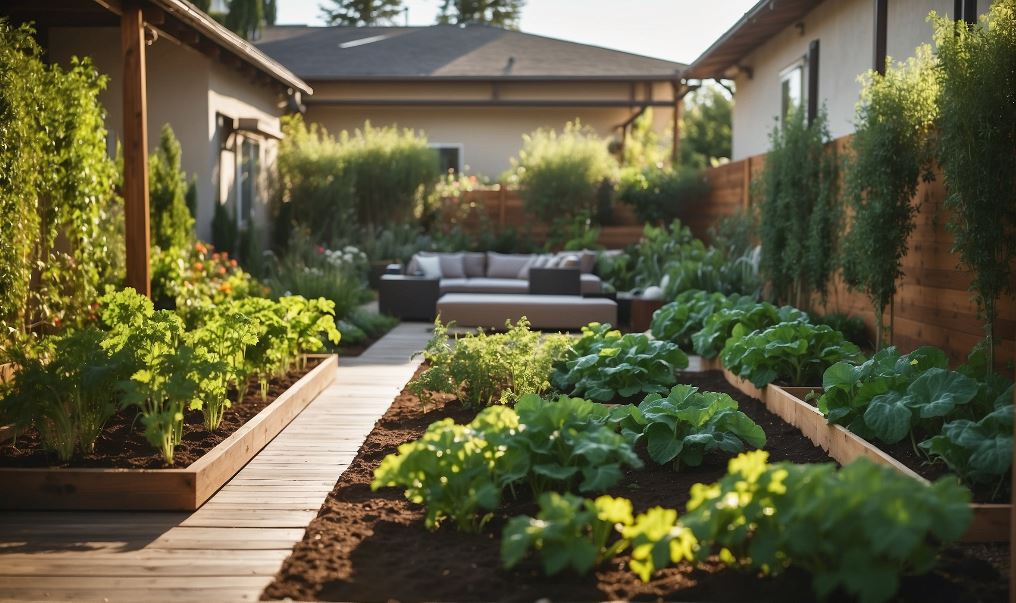Do you know how much water your garden needs? Understand the water-saving technologies and techniques that can put you out of water level trouble. It is peak time, and everyone wants to use water-saving technologies in their home gardening, especially in rich countries. These technologies do not belong to the gadgets, but give us solutions to control every drop of water before the level up. Here, we brought to you ways to conserve water with water-saving techniques and inventions that will inspire you with its outputs.
Understand the Basics of Water Saving in a Garden
Gardening between the living areas is mostly like inspiration. But, gardeners often worry about the water level and its flow. These hacks could help you save water to clean your home and apartment.
Importance of Water in Plant Growth
Imagine your garden plants are not growing due to less care. They need water and cutting edges to keep growing continually. The water is a basic need for a plant to get some nutrients to grow faster. The plant soil absorbs water to give plants a strong push in the nutrient form. Including water, garden plants also need sunlight to ensure the consumption of water and sunlight. This process is called photosynthesis and almost all gardeners know it’s important.
As we know, excess of everything is bad for health, so, this quote also implements the plants, that need an average amount of water that can fulfil their consumption requirements. You can find valuable resources on Farm Pioneer, implementing a comprehensive look into this process and water usage in the garden.
Common Challenges in Water Management for Home Gardens
What is the twist of home gardening? Gardening ways to conserve water give your plants special care especially water has a basic role in which your plant grows faster and second is sunlight. The common challenge in gardening is watering that can be levelled up often. Overwatering can draw your plants, cause fungal diseases and destroy nutrients. This water overflow can convert your garden into a plant ghost town.
The real challenge that every gardener faces is a perfect balance of water. You must ensure your plants are getting an average amount of water and sunlight for the photosynthesis process. As a result, your plant will grow faster with a fresher look. However, in this modern decade, water-saving technologies come into play and give you solutions for the water balance.
Use of Water-Saving Technologies
The use of water-saving technologies for the garden is evolving and various ways to conserve water and inventions can control water balance according to the plants’ needs. These technologies are no doubt very beneficial because, in our busy life, this water-saving technology will help you to give this water-controlling duty to the water saving products.
Drip Irrigation Systems Watering Technology
In this planting system a network of small pipes or tubes dripping water accurately at the base of your plant. This process will take your time because a bottle of water with a small pipe is used to give water in the deep of your plant soil. This Drip Irrigation system can be applied in all covered areas of your gardening. Most gardeners think this system is ideal for their fields too. Because they can flow water at once any time to their whole fields or garden. This watering system works best especially on hot, windy days when water seems to disappear before reaching the roots.
Rainwater Harvesting: Utilizing Natural Resources
This technique is very useful and in the UK this is allowed to collect rainwater for harvesting within your property. So, if you have a large-scale garden and you want to water this garden through natural resources you can implement this Rainwater harvesting technology. This water is essential for the plants and usually free of chemicals. But, there is another system you just need to attach with it, and this water-saving technology system will provide accurate water to your plants and fields.
Soil Moisture Sensors: Smart Watering Solutions
This is a soil moisture sensor system that gives smart watering solutions for outdoor and indoor gardens. This technology keeps an eye on the soil moisture and detects the water flow with the help of sensors to tell you if the water flow is going up or down. This invention works like an assistant and ensures your plants get the accurate amount of water at the right time when your plant need it.
Water-Efficient Plant Choices: Sustainable Gardening
Choosing the right plant is like picking the right friend for your garden because you must take care of your friend. Few plants have consumption with enough water but few feed with minimal watering. So, the choice is yours! A native plant is also a great choice because it can easily grow within the local climate and almost all types of soil. Gardening these plants means they will take less water, less fuss and give a more green look that you deserve.
These water-saving technologies and product choices not only save water but also make gardening more manageable. These water-saving products work with you as a team member and help you nurture our garden sustainably.
Conserve Water in Your Garden
Not all solutions for water saving are the best but some high-valued DIY conserve water techniques work very well. These are the methods that everyone can do themselves. You need a bit of creativity to understand the gardening landscape. Here are some useful DIY techniques that can give you a big advantage in water conservation.
Mulching: A Simple Yet Powerful Technique
Mulching is a unique technique in which you will cover only your plant’s area with leaves, and woods over the surrounding soil surface. This simple technique works very fast. It will keep the soil moist by reducing water frequency.
Scheduling an Efficient Watering
Watering on time is everything for gardening, especially when it comes to watering your indoor garden. Watering your garden early in the morning or the evening is best. Because it will reduce water loss due to the sunlight and during the photosynthesis procedures. This schedule means you’re going to save water for your next few days. This schedule depends on how much water your plant needs daily. For this, you can make sure of your water-saving schedule through the water-saving products that are available in the market.
Implementing Greywater Systems at Home
This is one of the most popular ways to conserve water with watering systems used in UK homes. This system is very impressive to understand because in this system you use all wastewater in your garden. It is important to use eco-friendly soaps and cleaners. Setting up a greywater system is not as easy as direct watering. However, In the UK most homes are already designed with the greywater system. So, there is no need to make new routes for your wastewater into the garden.
These DIY solutions are working smarter and more famous in the past. This method needs a bit of knowledge to put effort and converting waste water into clean water for your gardening.
The Impact of Climate and Environment on Water Usage
Climate and environmental change play a main role in which the use of water in gardens can be less or increased than our plants need. Following are the Gardening tips in which you can give water efficiently into your garden.
Adapting Gardening Practices to Local Climate
For this bull shit, you must need to choose a better place for your garden where climate change could not destroy your plants. If you are living in a rainy region you need to choose a place that is under the shadows of a green sheet. Drought-resistant plants can be implemented by this procedure with short techniques. Water management in this scenario focuses more on proper drainage roots. It is like dressing for the weather and when the rain starts your garden will be covered with the sheets automatically or manually.
Impact of Soil Type on Water Needs
Soil is the soul of a plant, without this, you cannot survive in the fields. It means we need to understand the importance of soil and the average water that we are giving to plants through the soil. The type of soil is defined by how expert you are in your gardening. For example, if you use clay soil it means it will hold water longer but may need aeration for better absorption. Sandy soil, on the other hand, will drain quickly and might require frequent water again and again. The right soil preparation makes all the difference in gardening.
Benefits of Water-Saving in Gardening
Water-saving benefits for your gardening can lead you towards an ideal garden that can inspire you and anyone!
Cost Savings from Reduced Water Usage
With the help of water-saving techniques, gardeners can reduce their water bills if they use rainwater or water that is coming from the home drainage. The cost will be less and growth will be more than before. Because your plants can grow within the environment that they need. These cost-saving techniques and ideas can be sustainable and cost-effective for your future gardening and fields.
Contribution to Environmental Sustainability
The contribution to environmental sustainability in gardening has benefits and plays an important role in environment sustainability. If you want to use less water these methods can help you in saving water for less use. This will also reduce the energy including the carbon footprint that is required to manage and pump water absorption. The exact watering of your garden delivers good results towards a greener space in your home.
The aspect that is highlighted in this article is to consider both the immediate impacts of your well-deserved gardening.
Future Trends in Water Conservation for Gardening
If you are looking for the trends that can lead you in the future in water conservation you must shape up to be more and more efficient with water usage. Let’s discuss some more about future gardening implementations.
Emerging Technologies and Innovations
The small gardens in a home connect to your devices, telling you exactly how much water your plants need. You can adjust your planting weather changes accordingly in real-time. Another method is to use alternative water resources, like rainy water and water that is wasted. By using these technologies you can save your water for your garden and provide the accurate water that your plants need.
The Role of Community and Education in Promoting Sustainable Practices
In a garden water conservation is not an easy job to do individually with few efforts. To get more awareness about managing an indoor garden you can get awareness from the community gardens and parks. It is all about the development within a culture where sustainable gardening takes place. With this kind of imagination, you can easily manage your garden with water-saving techniques.
Conclusion
The water-saving practices for your gardening are an important aspect. Now, it is clear that there are a lot of ways to conserve water introduced in the UK that are allowed by the government dept to save water for your gardens within your covered area.
With this help, you can manage your indoor and outdoor gardens with water-saving techniques. For this purpose, you can use water-saving products that are often used by gardeners. By using these technology products you can easily manage your plant soil absorption and also give a water flow automatically that is your plant required in a routine like humans.
Now, let’s roll up the topic and hope you will make water conservation very professional with best practices. Happy saving water gardening!



